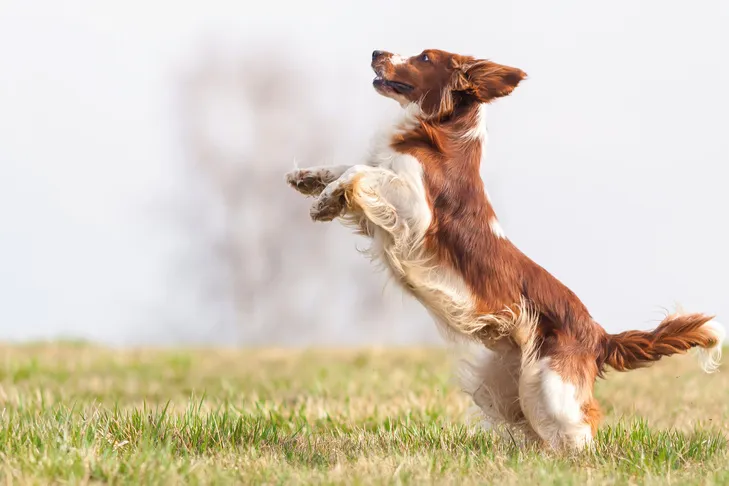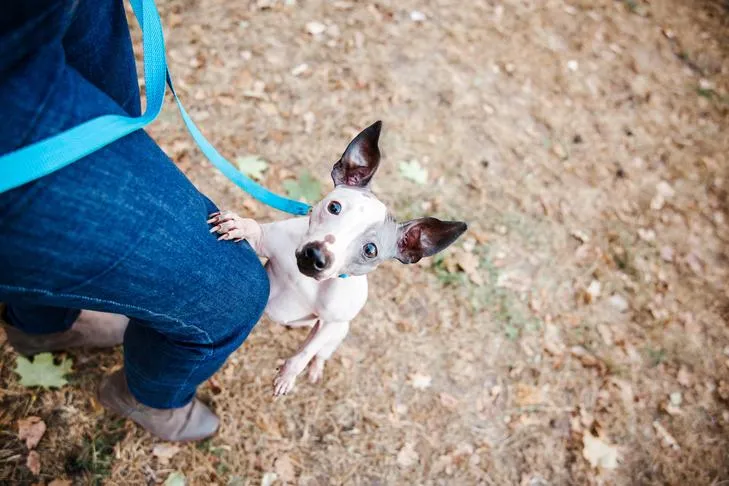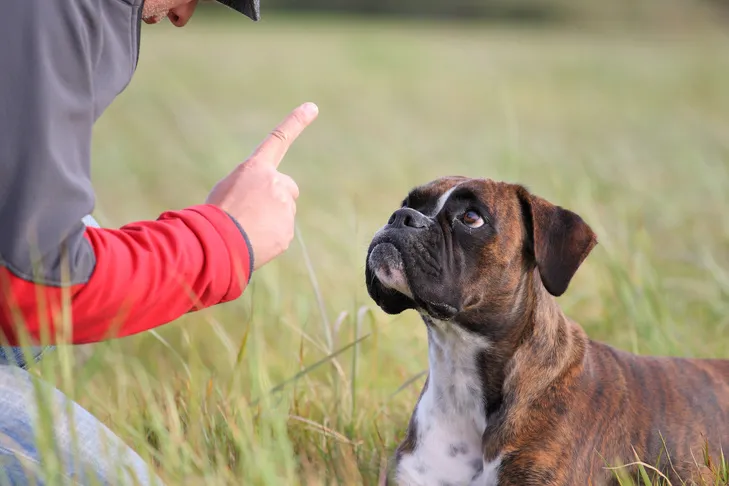Puppies jumping up to greet people is a common behavior that, while often seen as endearing initially, can quickly become a nuisance or even a safety concern as your puppy grows. Not only is it irritating to have muddy paw prints on clean clothes, but a larger puppy can inadvertently knock over children or seniors, posing a significant risk. Even small breeds can cause scratches or get overly excited. Fundamentally, your puppy is simply trying to say “hello” face-to-face, viewing jumping as an effective way to get your attention. So, understanding How To Prevent Puppy From Jumping Up is crucial for fostering polite interactions from a young age.
The key is to teach your puppy a specific greeting rule, such as “keep your front paws on the floor” or to “sit” politely. This provides a much safer and more courteous alternative for your furry friend to welcome you home and earn your much-desired attention. These 10 practical tips will guide you in teaching your puppy appropriate greeting behavior, ensuring they learn exactly how to interact respectfully with humans. This guide will walk you through 10 proven strategies on how to stop your puppy from jumping up on you, ensuring polite greetings and a well-behaved companion.
1. Only Greet Your Puppy When All Four Paws are on the Floor
The most effective approach to addressing unwanted behaviors like jumping is to teach your puppy an incompatible alternative behavior. Puppies learn faster and more easily when you clearly communicate what to do, rather than just what not to do. In the context of jumping, this means training your puppy to keep all four paws firmly on the ground. They simply cannot jump and stand simultaneously. Alternatively, you might prefer them to sit or lie down for greetings. Whatever polite rule you establish, be absolutely consistent: only provide greetings and attention when your puppy is successfully following this rule. Avoid sending mixed signals; for instance, don’t allow jumping when you’re in casual clothes but forbid it when dressed up.
2. Give Immediate Attention As Soon As Your Puppy’s Front Feet Hit the Floor
Puppies, like all dogs, will repeat behaviors that yield desired outcomes. Therefore, as long as your puppy adheres to your chosen greeting rule, such as keeping their front feet on the floor, it’s essential to provide immediate praise and petting. Your puppy craves the reward of your attention, so make sure they receive it instantly whenever they’re doing the right thing, especially during the crucial learning phase. Avoid delaying your greeting to take off your coat or shoes; your puppy might become impatient and resort to jumping to get you to notice them.
3. Remove Attention When Your Puppy Jumps
Conversely, the only way to stop jumping is to cease reinforcing it. Never reward a behavior you wish to eliminate. If your puppy jumps on you, promptly withdraw what they desire most – your attention. Try calmly turning your back or walking away, so your puppy understands that jumping produces the opposite effect of what they intended. However, the moment your puppy’s four paws are on the floor again, turn back and offer quiet praise and gentle petting. This consistent response helps your puppy recognize their behavior as a clear “on/off switch” for your attention, and guides them toward appropriate ways to get your dog to not jump on people.
 A happy Welsh Springer Spaniel puppy excitedly jumping up outdoors, demonstrating a common behavior owners want to prevent.
A happy Welsh Springer Spaniel puppy excitedly jumping up outdoors, demonstrating a common behavior owners want to prevent.
4. Set Your Puppy Up for Success
While ignoring jumping and rewarding proper greetings is effective, it can be frustrating for a puppy as it relies on trial-and-error learning. To accelerate the process and build confidence, proactively set your puppy up for success. Make it as easy as possible for them to follow your greeting rule. If your rule is for them to sit, then ask them to sit the moment you walk through the door. If “four on the floor” is your requirement, encourage them to stay standing.
An excellent technique to prevent your puppy from jumping is to scatter small, enticing treats on the floor as you enter. Most puppies can’t resist free goodies, and they certainly can’t jump and sniff the ground simultaneously. You’ll need to be quick, but if you provide the food before your puppy even thinks about jumping, you effectively reward the “four on the floor” position with both attention and treats. Your puppy will quickly grasp your greeting rule, and you can gradually reduce the reliance on food rewards.
5. Always Reward Your Puppy for Proper Greeting Behavior
Your puppy will learn appropriate greeting behavior much faster if their actions consistently and immediately influence your attention – four feet on the floor earns attention, while jumping makes it disappear. This means you must always reward your puppy if they follow your greeting rule. Never withhold your attention once your puppy’s feet finally touch the floor, even if you’re feeling irritated because they just jumped for a few minutes. Allowing your frustration to affect your response will only confuse your puppy and undermine the consistency crucial for effective learning. Consistency is paramount, especially when you’re aiming to teach your dog to stop jumping on people and promote polite interactions.
6. Don’t Grab or Push Your Puppy Away
It’s important to remember that your puppy jumps to gain your attention. Even a negative physical response, such as grabbing your puppy, holding their paws, or pushing them away, still counts as attention in their eyes and can inadvertently reward the jumping behavior. Instead of reducing the frequency, this can actually lead to more jumping in the long run. Worse, for many puppies, getting physical can be misinterpreted as an invitation to engage in roughhouse play, causing them to return with even more vigorous jumping, believing it’s all part of a fun game.
 An American Hairless Terrier puppy jumping up on its owner's leg outdoors, illustrating an attention-seeking behavior.
An American Hairless Terrier puppy jumping up on its owner's leg outdoors, illustrating an attention-seeking behavior.
7. Don’t Put Your Knee Up When Your Puppy Jumps
You may have heard the advice to put your knee up to block your puppy’s chest as they jump to discourage the behavior. However, as discussed, this physical interaction can be perceived as attention or a wrestling game by some energetic puppies, producing the opposite of the desired effect. More significantly, for most puppies, it can create distrust and erode the precious human-canine bond. Your puppy is merely attempting to say “hello,” and responding with a physical block can feel like a punishment. You might even accidentally injure them. A puppy that doesn’t trust you can develop other behavioral issues, such as reluctance to come when called.
8. Keep Greetings Low-Key While Your Puppy Is Learning
Because your puppy is overwhelmingly happy to see you, it’s challenging for them to control their excitement. It requires a significant amount of emotional self-control for a young dog to resist the natural urge to jump and instead adhere to a new, polite greeting rule. You can make this easier for your puppy by keeping greetings low-key, especially during the learning phase. Puppies can keenly read our emotions, so if you’re overly excited, they will mirror that enthusiasm. Instead, strive to remain calm and quiet, even when offering praise. As your puppy begins to grasp the new behavior, you can gradually increase your enthusiasm until you can match their joy without triggering unwanted jumping.
9. Prevent Your Puppy From Jumping on Guests
You aren’t the only one who can accidentally reinforce your puppy’s jumping behavior. Other family members, visitors, and even strangers on the street can all inadvertently reward jumping if you’re not proactive. To prevent this, implement effective management techniques. For example, keep your puppy on a leash when guests arrive, limiting their ability to approach and jump. Even better, teach your puppy to “go to their place,” such as a mat or bed, or crate train your puppy so they are calmly contained when guests are at the door. Utilizing a baby gate to block off the front hall can also be a simple and effective barrier. To proactively stop your dog from jumping on visitors, especially when they are still learning, management techniques are crucial.
 A man training a Boxer puppy to lie down calmly outdoors, demonstrating appropriate greeting behavior and self-control.
A man training a Boxer puppy to lie down calmly outdoors, demonstrating appropriate greeting behavior and self-control.
10. Ask Guests and Strangers to Follow Your Greeting Rule
Don’t hesitate to clearly communicate with guests and even polite strangers about what your puppy should do before they receive a greeting. While your puppy is still learning, kindly ask people to completely ignore your puppy unless you explicitly say it’s acceptable. It’s also wise to avoid unfamiliar strangers until your puppy has mastered greetings with friends and family who you know will cooperate with your training methods. When encountering strangers, you can use a “watch me” cue or distract your puppy with a hand touch command or a favorite toy until the stranger has passed by.
Preventing your puppy from jumping up requires patience, consistency, and clear communication. By implementing these ten tips, you’re not just curbing an unwanted behavior but actively teaching your puppy how to greet people politely and respectfully. Remember that puppies are eager to please and respond well to positive reinforcement and clear boundaries. Celebrate every small victory and remain consistent in your training efforts. By consistently applying these methods, you’ll be well on your way to stopping puppies from jumping on you and fostering a respectful bond, ensuring your “Dog Care Story” is one of harmonious companionship.
